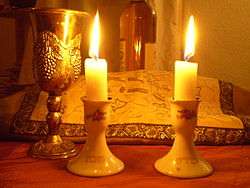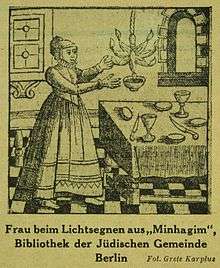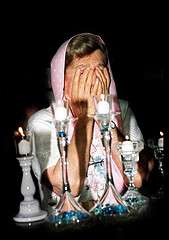Shabbat candles
Shabbat candles (Hebrew: נרות שבת) are candles lit on Friday evening before sunset to usher in the Jewish Sabbath.[1] Lighting Shabbat candles is a rabbinically mandated law.[2] Candlelighting is traditionally done by the woman of the household, but in the absence of a woman, it is done by a man. After lighting the candles, the woman moves her hands over the candles and towards her (as if bringing in or guiding in the Sabbath); she then covers her eyes and recites a blessing.[3]

History

The first record of the complete text of the blessing is from the Siddur of Rav Amram, written by Amram Gaon in the 9th century. He then cites Talmudic sources that a blessing was mandatory.
Due to a dearth of earlier sources, with the exception of the Siddur of Rav Amram, it has been argued that, in Europe, Jewish women lit Shabbat lamps without a blessing until the 11th century. At that time, it is claimed that a blessing was introduced based on the blessing over the Chanukah menorah, which is many centuries older. This blessing is identical to the one found in the Siddur of Rav Amram. Rashi's granddaughter, Hannah, describes her mother lighting candles and reciting the blessing.[4] The requirement to light Shabbat candles is thus of rabbinic origin.[5][6] It is traditional to light two candles, but in some homes an additional candle is lit for each child. The lighting of Shabbat candles has a dual purpose: To "honor Shabbat" (כבוד שבת) and create shalom bayit or domestic peace (שלום בית).
In Yiddish, lighting the candles is known as licht bentschen ("light davening") or licht tsinden ("light kindeling").
Time
The candles must be lit before the official starting time of Shabbat, which varies from place to place, but is generally 18 or 20 minutes before sunset. In some places the customary time is earlier: 30 minutes before sunset in Haifa and 40 minutes in Jerusalem, perhaps because the mountains in those cities obstructed the horizon and once made it difficult to know if sunset had arrived.
Blessing

| Hebrew | Transliteration | English |
|---|---|---|
| בָּרוּךְ אַתָּה ה', אֱ-לֹהֵינוּ מֶלֶךְ הָעוֹלָם, אֲשֶׁר קִדְּשָׁנוּ בְּמִצְוֹתָיו, וְצִוָּנוּ לְהַדְלִיק נֵר שֶׁל שַׁבָּת. | Barukh ata Adonai Eloheinu, Melekh ha'olam, asher kid'shanu b'mitzvotav v'tzivanu l'hadlik ner shel Shabbat. | Blessed are You, LORD our God, King of the universe, Who has sanctified us with His commandments and commanded us to light the Shabbat candle[s]. |
Chabad families add the word "kodesh" ("holy") at the end of the blessing, making "... the candle of holy Shabbat," (ner shel Shabbas kodesh).
References
- Shabbat Candles, Feminine Light
- Shulchan Aruch, Orach Chayim 263:2
- Jewish Virtual Library, Shabbat
- When Chanukah Falls on the Sabbath Jews Double the Light Archived 2013-11-12 at Archive.today
- Maimonides Hilchot Shabbat 5:1
- Meiri, Talmud Shabbat 25b
- Westenholz, Joan Goodnick (2004). Let There Be Light: Oil Lamps from the Holy Land (PDF). Jerusalem: Bible Lands Museum. p. 17. ISBN 9789657027141.
- "Archaeological Find Shines Light on Shabbat Innovation". Jewish Telegraphic Agency. July 26, 1996.
Further reading
- B.M. Lewin, The History of the Sabbath Candles, in Essays and Studies in Memory of Linda A. Miller, I. Davidson (ed), New York, 1938, pp.55-68.
